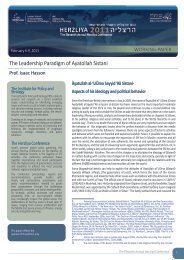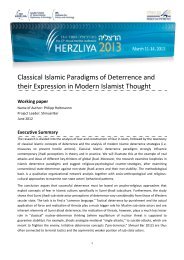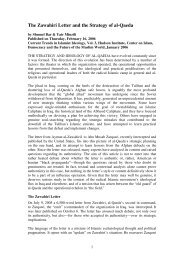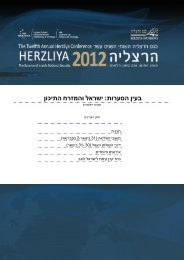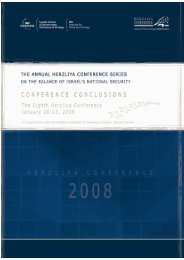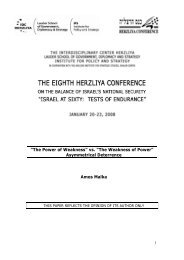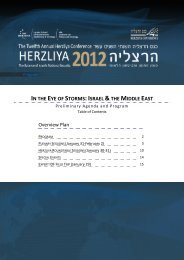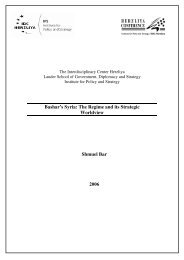Iran: Cultural Values, Self images and Negotiation Behavior
Iran: Cultural Values, Self images and Negotiation Behavior
Iran: Cultural Values, Self images and Negotiation Behavior
Create successful ePaper yourself
Turn your PDF publications into a flip-book with our unique Google optimized e-Paper software.
<strong>Self</strong>-Images <strong>and</strong> StereotypesBaqara would find there a hair from Khomeini’s beard. Even declared secular<strong>Iran</strong>ians are said to have feared to open the Koran.It is said that the <strong>Iran</strong>ian, even if he is a proclaimed atheist, believes in the h<strong>and</strong> ofGod in human affairs. Therefore, events that are not part of a conspiracy of human –but almost omnipotent – Great Powers or international organizations, are frequentlyattributed to divine retribution, trial, or reward. The vicissitudes of the Iraq-<strong>Iran</strong> warwere so presented to the public; <strong>and</strong> the accident that caused the abortion of theAmerican hostage rescue mission in the Tabass desert was the h<strong>and</strong> of Allah.Social Mobility <strong>and</strong> HierarchyBe the historic cause of this Persian individualism as it may, it is itself seen as acause of certain important political features widely considered to be characteristic of<strong>Iran</strong>ian society. It is linked to the absence of a caste system <strong>and</strong> the existence of apotential for socio-economic mobility, unusual in Middle East traditional societies.Indeed, <strong>Iran</strong>ian mythology 80 treats with honor figures of the lower class who haveperformed great deeds. Recorded <strong>Iran</strong>ian history also provides examples ofindividuals from the lowest strata of society who rose by way of exceptional talents tothe top of the pinnacle. 81 This acceptance of social mobility is also at the root of thewillingness of <strong>Iran</strong>ians to accept leaders without respect to their social origins. 82 Thesuccess of the Communist Tudeh party in <strong>Iran</strong> during the twentieth century also canbe attributed, at least partially, to the receptiveness of <strong>Iran</strong>ian culture to egalitarianideas.In a seeming contradiction to individualism <strong>and</strong> revolutionarism (see below),acceptance of authority (as long as it lasts) <strong>and</strong> subservience have also been seen ascharacteristics of <strong>Iran</strong>ian society. This has been attributed to the history of despoticrulers in <strong>Iran</strong> <strong>and</strong> to the <strong>Iran</strong>ians’ inherent pragmatism regarding force superiority.<strong>Iran</strong>ian society is at any given moment highly hierarchical. Even the uninitiated caneasily tell, watching two <strong>Iran</strong>ians meet, which of them is the senior. 83 <strong>Iran</strong>ian socialstereotypes differentiate between the elite (khawaas) <strong>and</strong> the common folk (awaam).The former are the traditional leaders; the latter are the traditional followers. <strong>Iran</strong>ianconcepts of social <strong>and</strong> political mobilization are intimately linked to thisdifferentiation; the khawaas are the people who are capable of dealing with the realstory, those who are “in the know”, while the common people are not expected tomake their own decisions <strong>and</strong> therefore do not have the “need to know.” Much of thecriticism conservatives level on the Reformists relates to their presumption to apply80 The classic example is that of Kawah, the legendary blacksmith who led a rebellion against theoppressive ruler, Zuhuq.It is of interest, however that while Kawah became a revered legendary figure(his blacksmith's apron was for ages said to be the royal st<strong>and</strong>ard of Persia), he is honored, inter alia,due to the fact that he refused to take the throne for himself <strong>and</strong> placed Faridun, a member of thePishdadian Royal House, on the throne.81 Even some of the Shahs of <strong>Iran</strong> began their rise to power from lowly stations: Yaqub bin Lais,Suffari (the Pewtersmith), came to power in the ninth century; Sabugtagin came up the ranks of thearmy to the throne in the tenth century as did Nadir Quli in the eighteenth, <strong>and</strong> Riza Khan in thetwentieth. Similarly, Mirza Taqi Khan (Amir Kabir), Chief Minister in the nineteenth century underNasir al–Din Shah was born the son of a cook.82 Wilson 306–307.83 This is an observation as good today as it was when Herodotus noted it in his Histories.19



